1 Tb 7200 Rpm Sata 128 Gb M2 Ssd Review
Best NVMe SSD for gaming in 2022
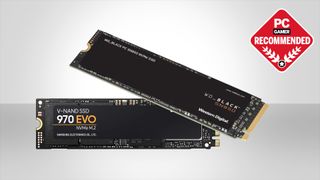
The best NVMe SSD makes y'all never want to get back to a regular old hard drive once more. In the race to load your games fast and motion your data around, NVMe SSDs are always in first place. They're incredibly fast, reliable, and worth investing in. Outside of a new GPU, which can be tough to go a concord of correct now, an NVMe SSD is the adjacent biggest upgrade for your rig.
Even modernistic consoles are touting some of the best NVMe SSDs—both the Xbox Series X and PlayStation 5 boast speedy NVMe SSDs and you don't want to get left behind by the consoles at present, do y'all? The engineering that makes the nearly of the Xbox's storage (DirectStorage) will be finding its way onto our systems soon. What that means, is storage is well-nigh to get a lot more important for gaming PCs.
Thankfully, the SSD market is fierce right now, so great deals on quality SSDs are not uncommon. A speedy 1TB NVMe SSD might only set you lot dorsum $120, which isn't much more than than you'd pay for a clunky old SATA SSD. Equally long as y'all have an M.ii slot on your motherboard, NVMe is the identify to be.
We've tested loads of NVMe SSDs recently to find the very best options out at that place. Each drive nosotros've looked at is bachelor in a range of capacities with prices to friction match. And remember, larger drives perform better thanks to more controller channels existence used at higher capacities, so purchase a big a bulldoze if you can. It'll be worth it.
All-time NVMe SSD
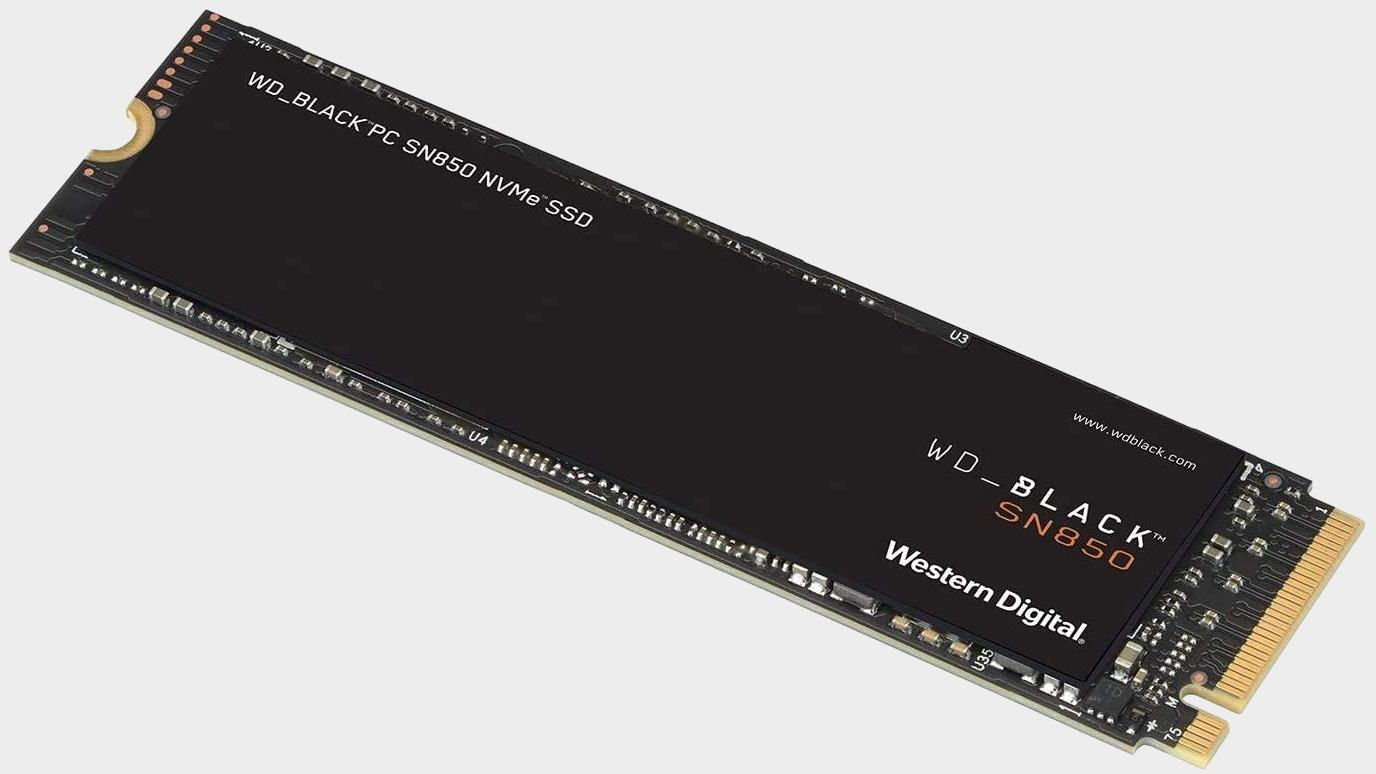
Our favorite WD Black SN850 config:
Western Digital has released some quality drives lately, with the SN750 beingness a mainstay of our all-time SSD for gaming guide and the likes of the SN550 offer incredible value for money. With the release of the SN850, Western Digital gets to add together some other trophy to its cabinet—the fastest PCIe SSD around. Thanks to the latest generation of PCIe interface, y'all will not find a faster, more reliable NVMe drive today.
The Phison E18-powered Sabrent Rocket four Plus has higher quoted sequential read and write figures. And while information technology's truthful that the SN850 trails slightly in some of the constructed benchmarks, we put more weight on the real-world tests, and here the SN850 is caput and shoulders in a higher place anything else in this group exam. It'due south the fastest at the FFXIV game load and PCMark10'southward full storage examination, and it isn't exactly sluggish in straight throughput either—managing 5,920MB/south reads and 5,021MB/s writes in Every bit SSD.
Information technology shouldn't come up as much of a daze to discover that this incredible operation comes at a cost, and this drive is definitely at the pricier stop of the spectrum, working out at $0.23/GB. It'southward also a toasty drive, hitting 77°C in performance. This shouldn't exist a problem in a well-ventilated case but maybe an issue in a more cramped organisation. Notwithstanding, if you want the fastest drive around, this is it.
Read our full Western Digital WD SN850 review.
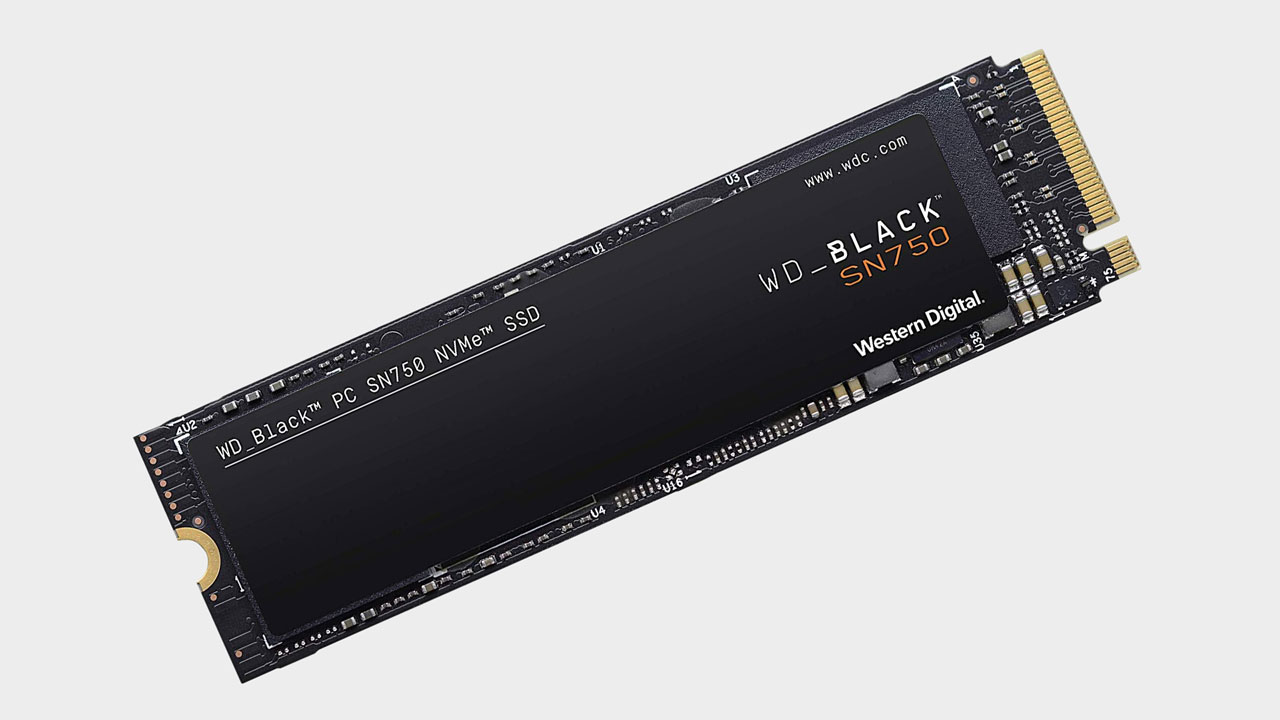
Our favorite WD Black SN750 config:
Western Digital has been a stalwart in the platter HDD world for many long years now. Its foray into the SSD market has shown an inherent competency in providing sensible, consumer-friendly storage. The new SN850 shows simply how far that competency has extended into the latest generation of PCIe interface. Though information technology's not without its faults, this M.2 form factor NVMe drive is a speed demon, made faster by a Gaming Mode you can toggle on or off in the company'south integrated SSD Dashboard software.
Of course, kicking it into overdrive also means cranking upwardly the heat, which, according to Western Digital, necessitates the use of a thermal heatsink. Sold separately, the heatsink model comes at something of a premium, but the company claims its "passive cooling features" assist with ushering in "optimal levels of operation."
In regular use, it's practically every bit fast equally the 970 Evo Plus. For the nigh intense workloads, Samsung wins out, just gamers aren't probable to fall into that user category. Several other drives employ the same SM2262EN controller, which often ways similar performance (eastward.g., the Mushkin Airplane pilot-E).
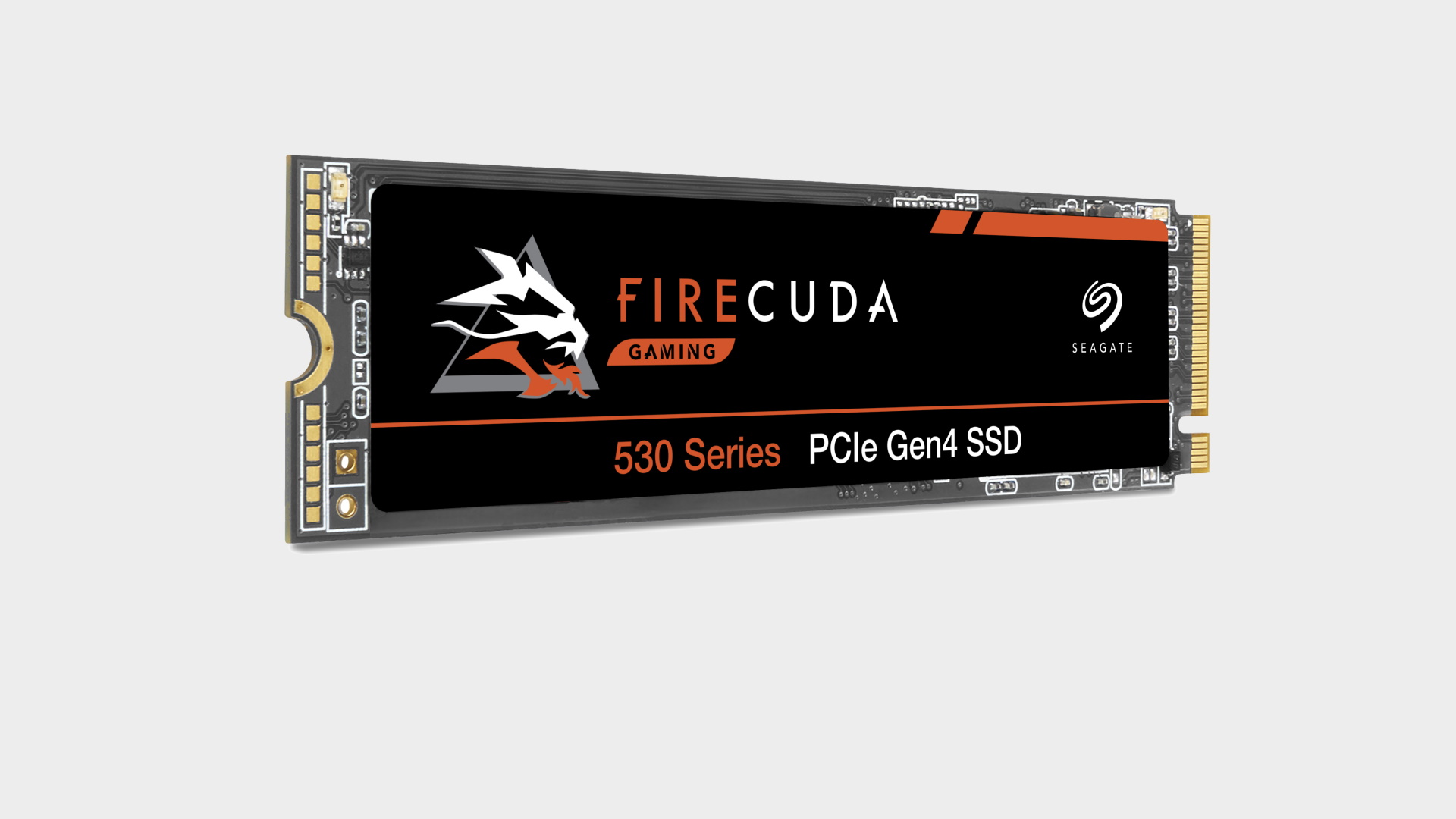
Our favorite Seagate Firecuda 530 config:
Of course Western Digital and Samsung are the big names in storage, and most peculiarly in the world of SSDs. Seagate may take taken a while to get into the solid land game, and particularly the PCIe 4.0 market, but it has arrived with a blindside with the Firecuda 530. With or without the heatsink (something that's necessary for its PlayStation 5 compatibility) the latest Seagate drive is a stunner.
Of course the rated sequential read/write speeds are fantastic, simply it's the endurance levels that really stand out compared to the competition. The 2TB bulldoze we tested has an unprecedented ii,550 TBW rating when it comes to endurance, which is something you won't encounter this side of an SSD made for Chia mining.
It combines brand-new Micron 176-Layer TLC NAND—the same retentiveness Crucial is using to bang-up issue with the new P5 Plus drives—with a Phison PS5018-E18 controller. Micron claims that its 176L TLC NAND is the best in the manufacture with a 30% smaller die size and a 35% improvement in read and write latency over its previous generation 96L NAND.
And in terms of performance the FireCuda 530 either matches or beats the big bois of the storage world, and when you add its leading sequential functioning and endurance rating, the Seagate 530 is at least the equal of any consumer SSD on the market place.
Read our total Seagate Firecuda 530 2TB review.
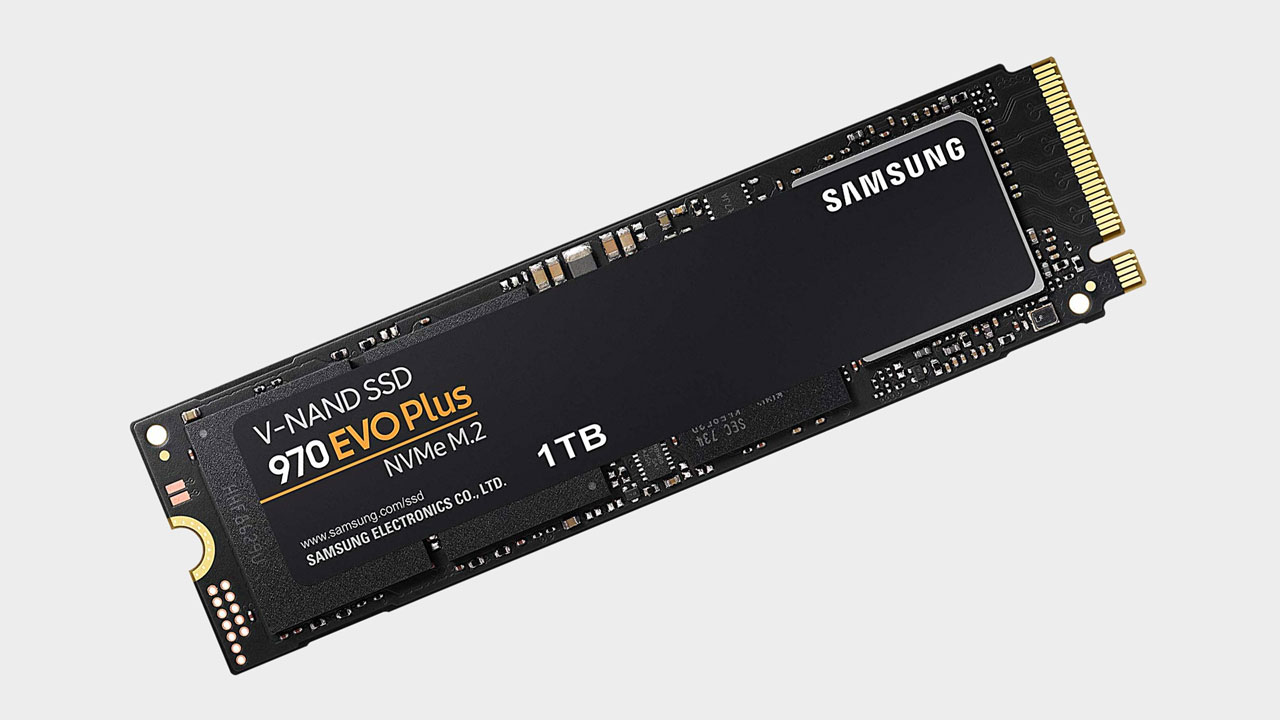
Our favourite Samsung 970 EVO Plus config:
There was a time it was hard to beat Samsung SSDs in the high-operation M.2 NVMe infinite, but with the shift towards PCIe 4.0 drives, nosotros've seen the likes of Western Digital and Sabrent take the pall forward. Simply PCIe 4.0 SSDs are still expensive, and back in the last generation, Samsung still has some fantastic drives. The Samsung 970 Evo Plus is still one of the fastest PCIe iii.0 One thousand.2 drives around.
Like the 970 Pro, the more recent 970 Evo Plus rates well for endurance, which bodes well for its longevity; the 1TB model is rated for 600TB of writes over five years or a whopping 329GB of writes per mean solar day. You'd demand to make full then wipe the bulldoze every three days to manage that many writes, which isn't a consumer or fifty-fifty prosumer workload. For reference, the SSD I've used the most notwithstanding only has 40TB of writes later on iv years.
The 500GB and 2TB models are certainly worth looking at if y'all want a lower cost or more capacity, respectively. But for about users, the 1TB drive strikes the sweet spot between performance, capacity, though Samsung's drive is notwithstanding pretty pricey.
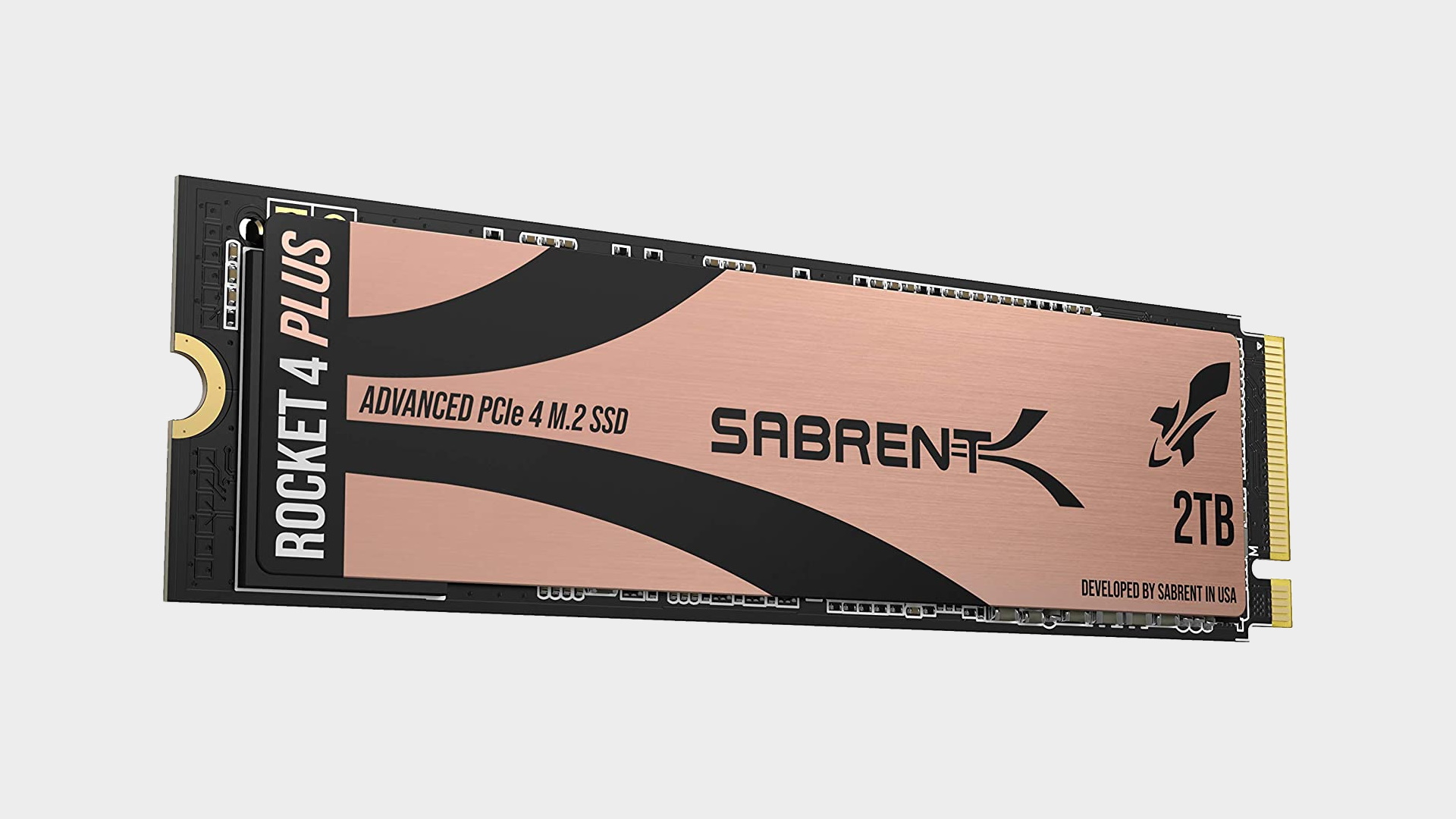
Our favorite Sabrent Rocket 4 Plus config:
The Sabrent Rocket iv Plus is the first drive in the lab to use the new Phison E18 controller, the follow-up to the immensely popular Phison E16 controller found in every showtime-gen PCIe 4.0 bulldoze. Offering peak reads of vii,100MB/due south and writes of 6,600MB/s, information technology'southward not only a major step upward from the first generation of PCIe 4.0 drives but a notable comeback over the Samsung 980 Pro, especially in terms of write performance.
In testing, this performance was built-in out, as well, with the faster write performance dominating Samsung's drive in the write tests. Real-globe performance didn't e'er tell the same story, although the differences between these top three drives can be slight. Yet, you lot're looking at AS SSD striking 5,868MB/southward for reads and five,630MB/south for writes. Impressive stuff.
An of import factor hither is that the Sabrent Rocket 4 Plus is the cheapest of these second-generation drives. The operation is so close that it makes the Sabrent SSD the sensible selection if y'all don't demand the absolute best performance around. This drive also runs cooler than the WD_Black SN850, which may be a cistron if you're looking for a drive for a cramped case.
Read our full Sabrent Rocket 4 Plus review.
All-time gaming keyboard | Best gaming mouse | Best SSD for gaming
All-time VR headset | Best graphics cards | All-time CPU for gaming
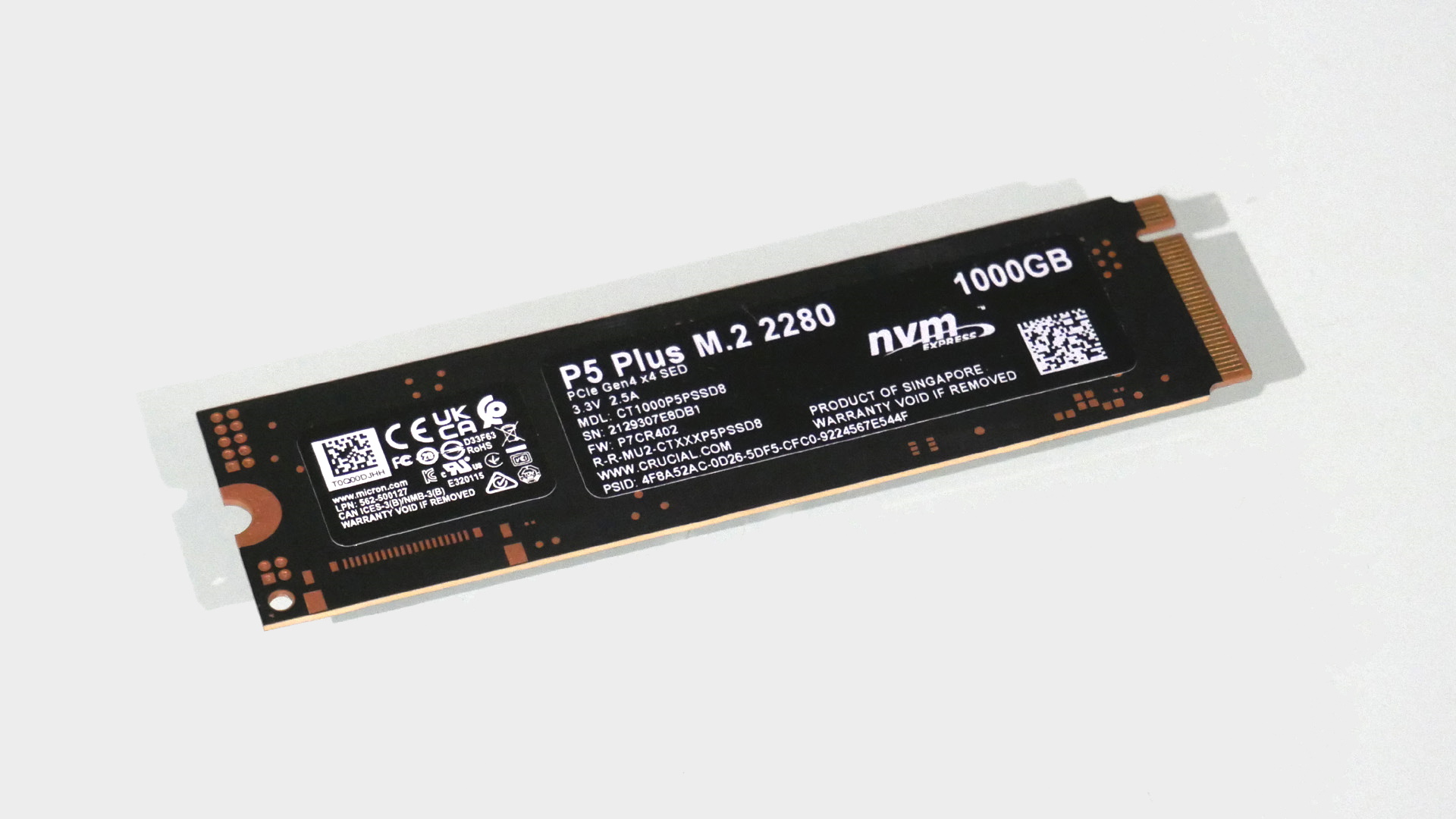
Our favorite Crucial P5 Plus config:
Cheaper alternatives
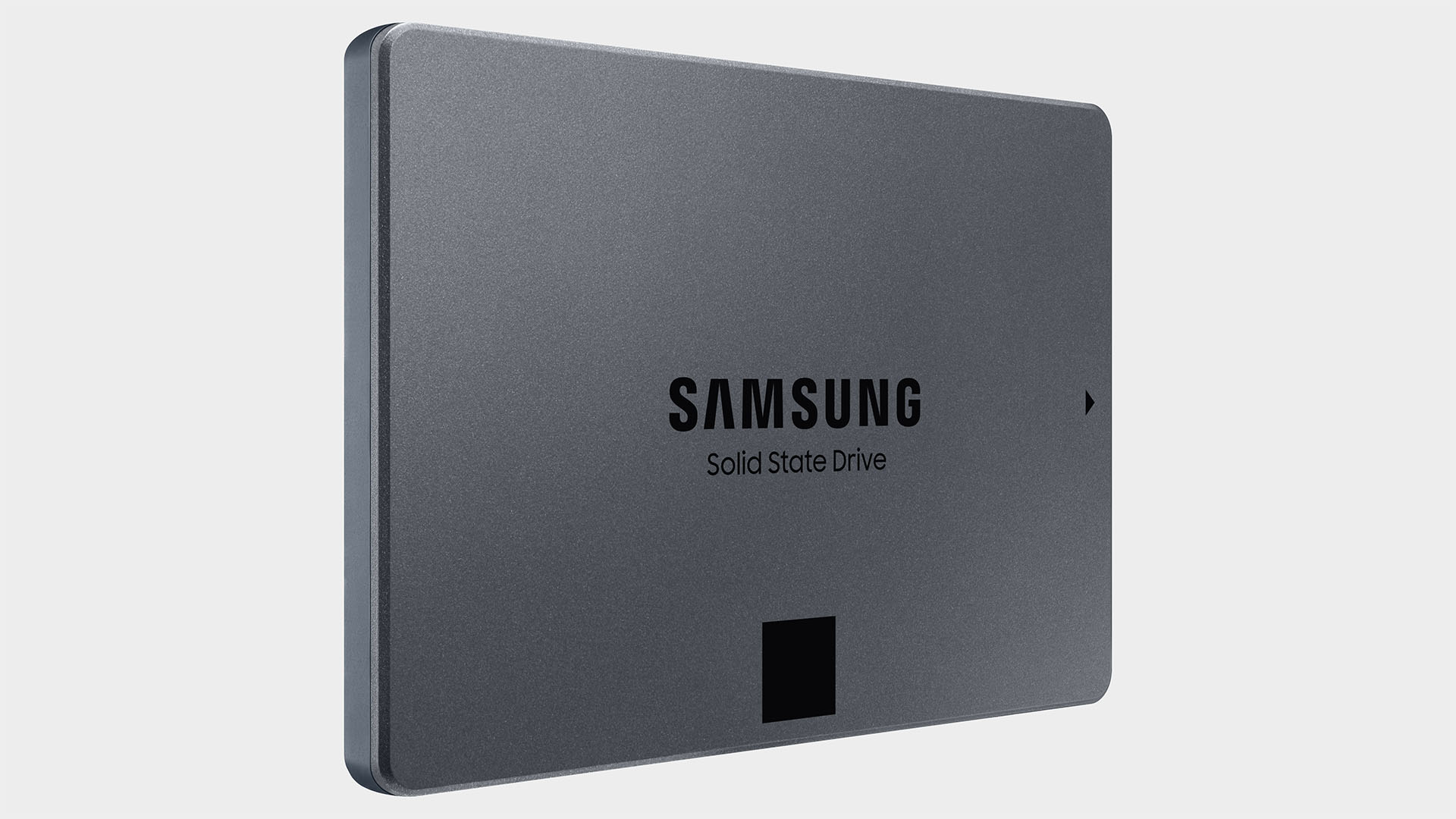
Though NVMe SSD pricing has dropped, high capacity SATA drives can be a bully place to store your ever-growing Steam library. The best SSD for your gaming PC may still be an affordable, loftier-capacity SATA bulldoze right now.
Crucial is one of the big names in affordable solid state storage, only has been notably tiresome at getting u.s. a new PCIe 4.0 SSD. It'southward been worth the wait, however, as the new P5 Plus is a fantastic entry-level Gen4 SSD. It may non accept the superlative speeds of the WD or Sabrent competition, but it can brand a big splash in terms of those all-important toll/performance metrics.
And, likewise importantly, it can easily outperform whatever PCIe 3.0 drive you can to mention, and for practically the aforementioned toll. Even if you're not running a motherboard with a PCIe 4.0 interface this will yet work in an older PCIe three.0 setup, and at the limits of that connection.
Since the showtime Gen4 SSDs launched there has been a quite significant toll premium every bit a barrier to entry, and with the P5 Plus that has come downwardly a hell of a lot. Using parent visitor, Micron's latest NAND flash retention, and it's own in-firm controller, Crucial has been able to keep costs downwards and performance up.
In the rarefied air of PCIe 4.0 speeds it'due south perchance a little lacklustre in meridian and random performance, only it'due south rocking TLC memory, not QLC, is withal pretty damned quick compared to older drives, and is fantastically affordable.
Read our full Crucial P5 Plus review.
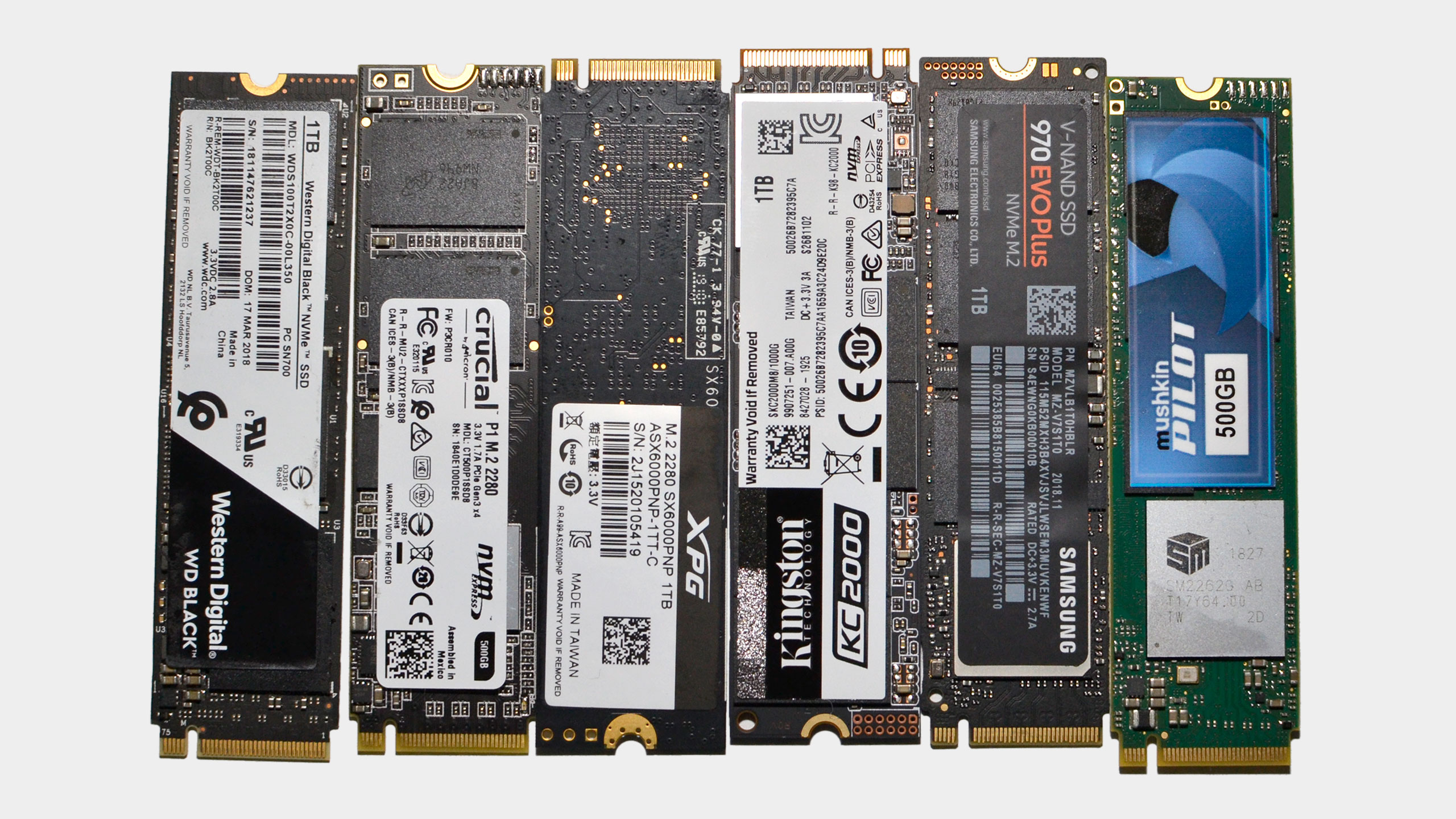
Best NVMe SSD FAQ
How do nosotros test NVMe SSDs?
We put every SSD we make it the PC Gamer labs through their paces in various benchmarks made up of a mix of synthetic tests and real-earth applications. To define a drives sequential throughput, we use ATTO SSD Benchmark for compressible information (a best-instance scenario) and Every bit SSD for incompressible data (more realistic). We also test random throughput with Every bit SSD and a combination of CrystalDiskMark vii.0 and Anvil Pro.
When it comes to the real-world tests, we time how long it takes to copy a 30GB game install across the bulldoze and use PCMark10 and Final Fantasy XIV: Shadowbringers, which includes a level load test. We also cheque operating temperatures to ensure that the drive isn't getting too hot and throttling.
Can I fit an NVMe SSD on my motherboard?
The M.2 socket has been included on motherboards of all kinds for many years at present, so the chances are that there's a spare slot sitting inside your existing gaming PC. Check out your motherboard'due south specs folio online before pulling the trigger on an NVMe SSD purchase, though, to be sure. Those harboring a board that'south a few years one-time now, do yourself a favor and make sure it supports booting from an NVMe drive first. Not all older motherboards do, especially if you're going back multiple CPU generations (maybe a total upgrade's due, if so).
What is NVMe, exactly?
The NVMe, or Non-Volatile Memory Limited interface, has been designed specifically with solid country drives in heed. In contrast, SATA, the previous interface in charge, was congenital to cater to about HDDs. The idea is, at the time, that no storage would always need to exceed its lofty max bandwidth. To the surprise of a few, new storage mediums such as solid land absolutely blaze past SATA's max bandwidth, and so a new protocol in NVMe was built-in.
That makes NVMe SSDs the perfect storage tech for gaming.
Running on the same basic interface equally your graphics card, NVMe SSDs deliver more than raw bandwidth and performance than any SATA-based SSD could ever offer. They're besides a lot smaller than any other hard drive or SSD too, which all means that the best NVMe SSDs are perfect for either that small course factor build you always wanted or a monstrous high-finish gaming PC build.
What'southward so special most NVMe?
The old storage paradigm was built on the thought of spinning disks. When SSDs hit the mainstream consumer marketplace back in 2007, they reset our expectations for storage. Moving from the mechanical world of hard drives to the silicon world of SSDs brought rapid improvements in performance, technology, capacities, and reliability. SSDs rapidly saturated the various SATA connections, and so faster alternatives were needed, but the interface was only part of the problem.
The AHCI (Avant-garde Host Controller Interface) command protocol was designed for much slower media (i.e., spinning magnetic disks). AHCI is inefficient with modern SSDs, and so a new standard was developed: NVMHCI (Not-Volatile Memory Host Controller Interface). Combine NVMHCI with a fast PCIe interface, and you take NVMe, Not-Volatile Retentivity Express. It's a much-improved interface adult around the needs of flash retention rather than spinning disks.
What's NVMe functioning like in the real world?
If you're copying a game from one drive to another or validating game files in Steam, faster NVMe drives brand a difference. They tin also shave off a 2d or two when it comes fourth dimension to load a game level, but the more than pregnant deviation is confronting difficult drives, where even a slower SATA SSD is much faster. Go beyond a sure bespeak, and all SSDs commencement to feel similar.
In other words, while the speed freak in me loves what NVMe brings to the table, I recognize that in do, it's usually not that noticeable. If you're looking to get the about from your coin when it comes time to build a gaming PC, good SATA SSDs remain an excellent selection, with prices at present falling below 10 cents per GB.
NVMe drives are becoming increasingly commonplace, and prices continue to drop. In the past twelvemonth, I've tested far more NVMe drives than SATA drives, mainly considering SATA drives are all starting to wait the same. Most striking the same ~550MB/south limit of the SATA interface for sequential IO, though random IO can still be a scrap problematic on some models. With budget NVMe prices now matching SATA drives, near new builds should seriously consider whether the actress power and data cables of SATA are necessary.
Source: https://www.pcgamer.com/best-nvme-ssd/
0 Response to "1 Tb 7200 Rpm Sata 128 Gb M2 Ssd Review"
Post a Comment